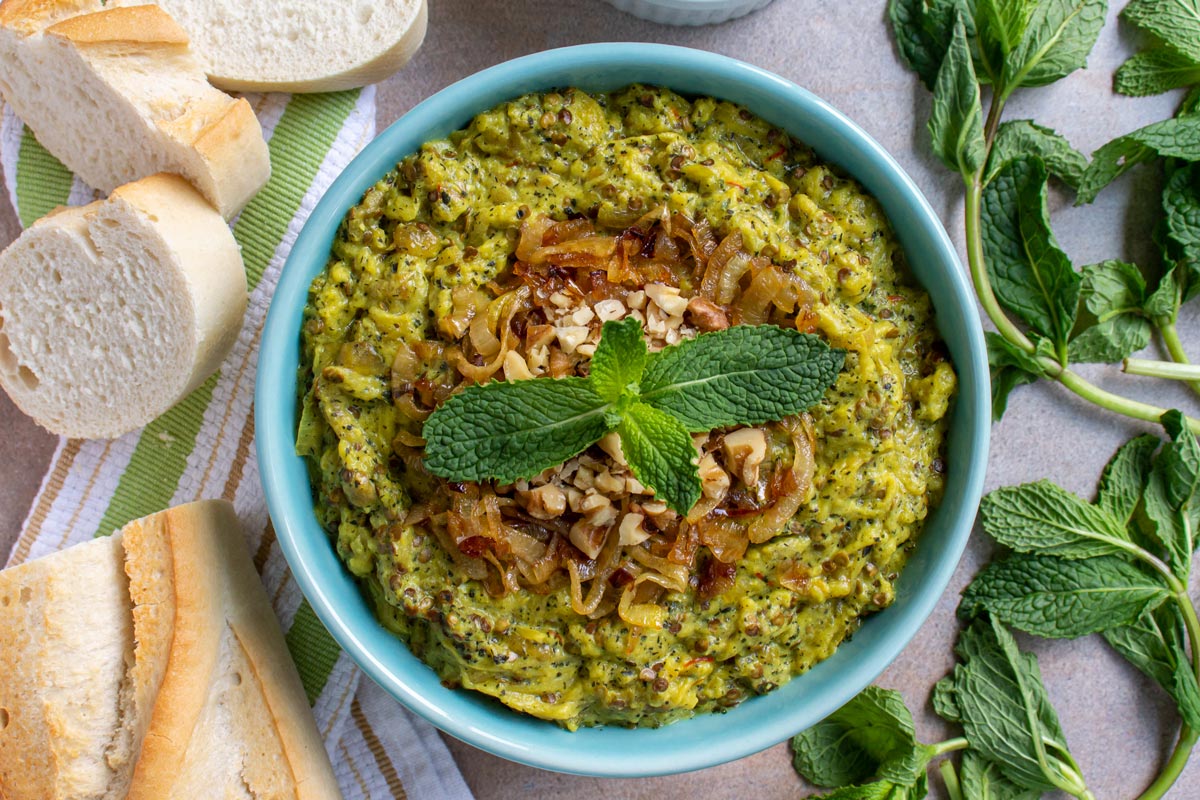Kashke Bademjan is a Persian eggplant dip which is served warm or at room temperature. It's impressive, flavorful, and couldn't be easier to make! This recipe is healthier than the typical method, as it roasts the eggplant instead of frying it.

(This recipe was originally published in August 2019, but was updated with new photos and content in 2023).
Kashke bademjan is sometimes written kashk-e bademjan or kashk e bademjan, and literally translates to kashk and eggplant in Persian. This Persian eggplant dip is great as a component to a larger meal, as a type of meze, or simply as a vegetarian snack!
It features caramelized onions, garlic, dried mint, saffron, turmeric, and is garnished with crunchy walnuts.
Kashke bademjan is delicious in the summer when local eggplants are in season. It's also lovely in cooler months as it's a comforting dip served warm.

As much as I enjoy a creamy, cool baba ghanoush, this may be my favorite eggplant dip. It has a nice sweetness from the onions and great crunch from the walnuts on top. To serve, scoop it onto pita bread, lavash, sliced baguette, or even pita chips or crackers.
Traditionally, one would peel, slice, fry, and later mash or puree the eggplant. I have lightened up the dip for a less guilty alternative, while still keeping the intense flavor profile.
Whereas a more typical kashke bademjan sometimes has a layer of golden-hued oil on the surface, this version cuts down massively on the oil, but still packs a ton of flavor!
Ingredient notes

- Eggplants: I recommend using Italian or globe eggplants instead of the more slender Asian style eggplants for this Persian eggplant dip. They are more fleshy and have a better yield for the purposes of this recipe. Also, Asian eggplants can sometimes shrink and dry up too much when roasting.
- Kashk: Kashk is a Middle Eastern ingredient made from drained yogurt. It's also referred to as Persian style whey. You can find it in Middle Eastern markets and online. You may also substitute plain yogurt or sour cream which still provides a wonderful creaminess and tang. I've eaten kashke bademjan with kashk and with yogurt, and they are both delicious. Don't feel compelled to buy a jar of kashk if you don't think you'll use it again. The yogurt works fine in a pinch!
- Walnuts: Crunchy walnuts are super traditional in kashke bademjan. They add great nutty flavor and a wonderful texture. You only need a couple tablespoons as your garnish, but if someone in your group has a nut allergy you can omit them entirely or serve them on the side for the others to add to their individual plates.
- Saffron: Saffron is a very expensive spice, but you'll only need a small amount for this recipe. Soak saffron threads in hot, but not boiling, water to help draw out the color and allow the saffron to mix more evenly into your Persian eggplant dip.

How to make a lighter Kashke Bademjan
Preheat the oven to 400°F. Place eggplants on a foil-lined sheet pan and roast (PHOTO 1), flipping over occasionally, until skin is blistered in spots, and the flesh is fork tender, about 45 minutes to an hour depending on the size of the eggplants (PHOTO 2).

Remove from the oven and let cool slightly. Peel off the skin and remove the stem. Place the flesh of the eggplants into a bowl (PHOTO 3) and mash with a potato masher until smooth (PHOTO 4). Set aside.

Meanwhile, heat olive oil in a large pot over medium heat. Add sliced onion (PHOTO 5), season with salt, and stir occasionally until softened and caramelized. Lower the heat to medium-low if necessary. This can take anywhere from 40 to 60 minutes. It will shrink down significantly (PHOTO 6).

Remove 2 tablespoons of caramelized onions for garnish, and set aside.
To the pot of remaining caramelized onions, add the minced garlic and dried mint. Stir to combine (PHOTO 7). Then add in the mashed eggplant, turmeric, and saffon/water mixture (PHOTO 8).

Cook for about 5 minutes until the eggplant is heated through, and the flavors have combined (PHOTO 9). Add the kashk, yogurt, or sour cream, mix thoroughly, and then season to taste with salt and pepper (PHOTO 10).

Transfer the eggplant mixture to a serving bowl and top with the reserved caramelized onions, chopped walnuts, and a sprig of fresh mint. Serve kashke bademjan warm or at room temperature with pita bread, lavash, or slices of baguette.
Please scroll to the bottom of the post for the full recipe (in a printable recipe card) including ingredient amounts and detailed instructions.

Expert tips
This lightened up recipe helps to avoid the mess of frying on your stove-top. Meanwhile the flavors are still fabulous with a fraction of the fat! It may not be the traditional cooking method, but it tastes just as good in my opinion.
This is a great dip for entertaining guests or even just snacking. I sometimes enjoy it as a light, meatless lunch with a chunk of bread.
You can make kashk e bademjan ahead of time and gently warm it back up before serving. You can eat it cold too, but it's better warm or at room temperature.
Prior to mixing in the kashk or yogurt, the dip can be frozen for up to 2 months, then defrosted, reheated, and combined with the kashk or yogurt before serving.
Even though using kashk is the correct and authentic way to make this popular Persian dip (the word kashk is in the name after all), in a pinch (and often) I have substituted plain, thick yogurt and it tastes fantastic as well. Don't let an ingredient substitution stop you from trying this recipe.

Other recipes you may like
- Spicy Red Lentil Dip
- Buffalo Chicken Dip
- Reuben Dip
- Spinach Fatayer (Lebanese Spinach Pies)
- Homemade Manti (Armenian Dumplings)
- Zankou Chicken Garlic Sauce
- Armenian Baked Macaroni and Cheese
- Sini Kofte (Baked Kofte)
- Eggplant and Parmesan Rotolo Pasta
- Browse all Armenian and Middle Eastern Recipes
Tried this recipe? Please leave a star ⭐️⭐️⭐️⭐️⭐️ rating in the recipe card below and/or a review in the comments section further down the page. You can also follow me on social media on Facebook, Instagram, and Pinterest!

Kashke Bademjan (Persian Eggplant Dip)
Ingredients
- 2 medium to large Italian/globe eggplants
- 1 tablespoon olive oil
- 1 large onion thinly sliced
- 4 cloves garlic minced
- 2 tablespoons dried mint
- ½ teaspoon ground turmeric
- ¼ teaspoon saffron steeped in 1 tablespoon hot water
- ½ cup kashk, plain yogurt, or sour cream
- Kosher salt and freshly ground black pepper
- 2 tablespoons chopped walnuts
- Sprig of fresh mint
Instructions
- Preheat the oven to 400°F. Place eggplants on a foil-lined sheet pan and roast, flipping over occasionally, until skin is blistered in spots, and the flesh is fork tender, about 45 minutes to an hour depending on the size of the eggplants. Remove from the oven and let cool slightly. Peel off the skin and remove the stem. Place the flesh of the eggplants into a bowl and mash with a potato masher until smooth. Set aside.
- Meanwhile, heat the olive oil in a large pot over medium heat. Add the onion, season with salt, and stir occasionally until softened and caramelized. Lower the heat to medium-low if necessary. This can take anywhere from 40 to 60 minutes. Remove 2 tablespoons of caramelized onions for garnish, and set aside.
- To the pot of caramelized onions, add the garlic and dried mint and stir to combine. Then add in the mashed eggplant, turmeric, and saffon/water mixture. Cook for about 5 minutes until the eggplant is heated through, and the flavors have combined. Add the kashk, yogurt, or sour cream, mix thoroughly, and then season to taste with salt and pepper.
- Transfer the eggplant mixture to a serving bowl and top with the reserved caramelized onions, chopped walnuts, and a sprig of fresh mint. Serve warm or at room temperature with pita bread, lavash, or slices of baguette.
Notes
- Kashk is a Middle Eastern ingredient made from drained yogurt. It's also referred to as Persian style whey. You can find it in Middle Eastern markets and online. You may also substitute plain yogurt or sour cream which still provides a wonderful creaminess and tang.
- I recommend using Italian or globe eggplants instead of the more slender Asian style eggplants for this Persian eggplant dip. They are more fleshy and have a better yield for the purposes of this recipe. Also, Asian eggplants can sometimes shrink and dry up too much when roasting.
- If someone in your group has a nut allergy you can omit the walnuts entirely or serve them on the side for the others to add to their individual plates.
- You can make kashke bademjan ahead of time and gently warm it back up before serving. You can eat it cold too, but it's better warm or at room temperature.
- Prior to mixing in the kashk or yogurt, the dip can be frozen for up to 2 months, then defrosted, reheated, and combined with the kashk or yogurt before serving.
Nutrition
*All nutritional information is based on third-party calculations and should be considered estimates. Actual nutritional content will vary with brands used, measuring methods, portion sizes and more.*











Mary Kabakian says
This is great for snacking or as an appetizer. It really has a lot of flavor with so few ingredients. Two thumbs up for sure!